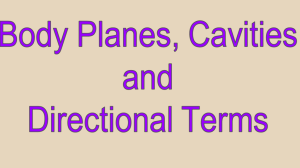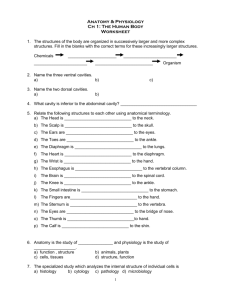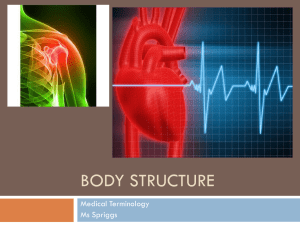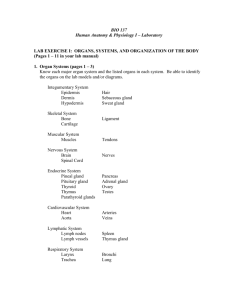General Body and Directional Terms
advertisement
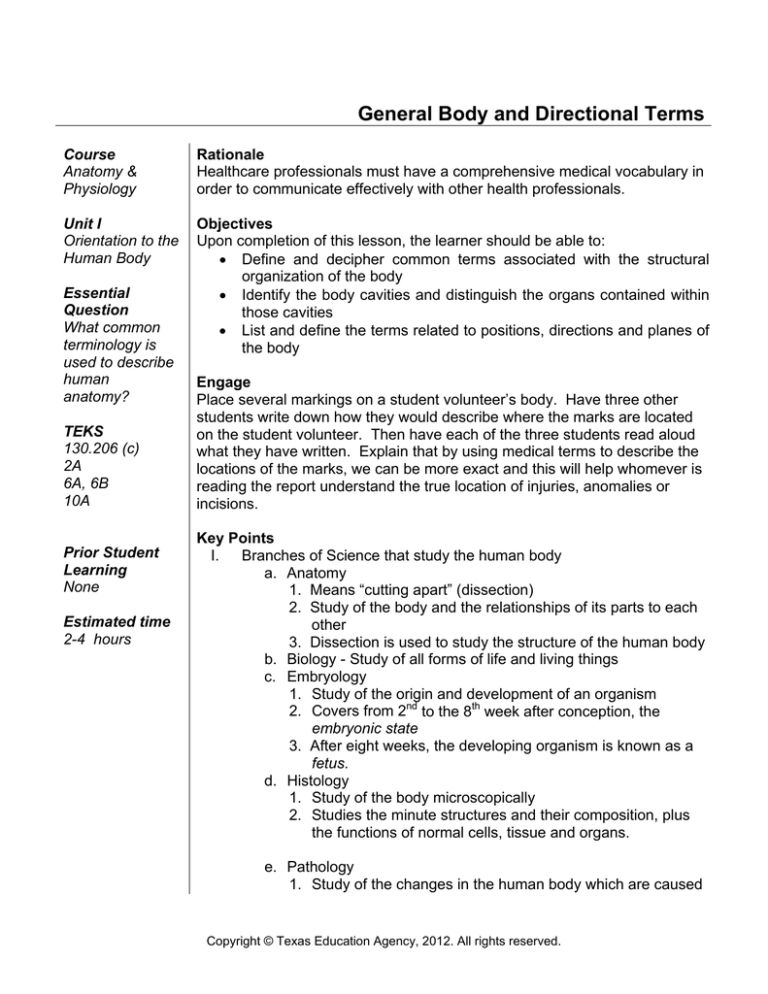
General Body and Directional Terms Course Anatomy & Physiology Rationale Healthcare professionals must have a comprehensive medical vocabulary in order to communicate effectively with other health professionals. Unit I Orientation to the Human Body Objectives Upon completion of this lesson, the learner should be able to: • Define and decipher common terms associated with the structural organization of the body • Identify the body cavities and distinguish the organs contained within those cavities • List and define the terms related to positions, directions and planes of the body Essential Question What common terminology is used to describe human anatomy? TEKS 130.206 (c) 2A 6A, 6B 10A Prior Student Learning None Estimated time 2-4 hours Engage Place several markings on a student volunteer’s body. Have three other students write down how they would describe where the marks are located on the student volunteer. Then have each of the three students read aloud what they have written. Explain that by using medical terms to describe the locations of the marks, we can be more exact and this will help whomever is reading the report understand the true location of injuries, anomalies or incisions. Key Points I. Branches of Science that study the human body a. Anatomy 1. Means “cutting apart” (dissection) 2. Study of the body and the relationships of its parts to each other 3. Dissection is used to study the structure of the human body b. Biology - Study of all forms of life and living things c. Embryology 1. Study of the origin and development of an organism 2. Covers from 2nd to the 8th week after conception, the embryonic state 3. After eight weeks, the developing organism is known as a fetus. d. Histology 1. Study of the body microscopically 2. Studies the minute structures and their composition, plus the functions of normal cells, tissue and organs. e. Pathology 1. Study of the changes in the human body which are caused Copyright © Texas Education Agency, 2012. All rights reserved. by disease 2. Study changes due to disease that alter the function of the body f. Physiology - Studies the normal activity and functions of the body II. Body in General a. Cells are the basic unit of life b. Cells that perform similar functions join together, or group together, to form tissue. c. Groups of different types of tissue join together to form an organ d. Groups of organs work together to perform a complex function, for a body system e. Trillions of cells that vary in size and shape according to their purpose or function f. Specialized cells are responsible for the functions of growth, secretions, excretions, nutrition, and reproduction g. Mechanical, chemical and nervous stimulation activate the cells III. Cells a. Epithelial cells 1. Skin cells 2. May be square and flat b. Fat cells - contain large vacant spaces for fat storage c. Muscle cells - long and slender d. Nerve cells - may be long and have fingerlike extensions, which carry impulses IV. Tissues a. Connective tissue 1. Supports and encases body structures. 2. Most widespread kind of tissue throughout the body 3. Holds organs in place and connects body parts to each other 4. Main types of connective tissue: (a) Bone that supports the body (b) Cartilage which is firm but bendable (c) Dense fibrous: makes up the tendons and ligaments (d) Loose that connects adjoining structures (e) Adipose that pads and protects, stores fat, and insulates the body against heat loss b. Epithelial tissue 1. Found in the skin and in the lining of blood vessels 2. Makes up the outer covering of external and internal body surfaces and the lining of the digestive, respiratory, and Copyright © Texas Education Agency, 2012. All rights reserved. Page 2 of 25 urinary tracts c. Muscle tissue 1. Provides movement 2. The main function is to contract d. Nerve tissue 1. Conducts impulses to and from the brain 2. Is composed of nerve cells called neurons 3. Needs more oxygen and nutrients than any other body tissue V. Organs a. When two or more kinds of tissue work together to perform a specific function, you have an organ b. Although organs act as units, they do not function alone c. Several organs join together to form a system and perform a body function d. Each system has a special function VI. Systems a. Cardiovascular system 1. Includes the heart and blood vessels 2. Carries the blood throughout the body b. Digestive or gastrointestinal system 1. Includes the mouth, esophagus, stomach, and the small and large intestines 2. Digests and absorbs food and excretes waste c. Endocrine system 1. Made up of a variety of glands 2. Manufactures and distributes hormones d. Integumentary system 1. Includes the hair, skin, nails, sweat glands and oil glands 2. Helps protect the body e. Lymphatic system 1. Works with the cardiovascular system 2. Helps protect the body against disease-causing organisms f. Musculoskeletal system 1. Composed of bones, muscles, tendons and ligaments 2. Provides the framework for the body 3. Supports organs 4. Permits movement in the body g. Reproductive system 1. Includes the uterus, ovaries, testes, and prostate 2. Provides for reproduction h. Respiratory system 1. Includes the trachea, lungs, and bronchi 2. Provides for the exchange of gases 3. Absorbs oxygen Copyright © Texas Education Agency, 2012. All rights reserved. Page 3 of 25 4. Expels carbon dioxide Sensory or special senses system 1. Made up of the eyes, ears, nose, mouth, skin and nerves 2. Acts as the body’s external perception/alarm system by letting in light, sound, taste and touch (both pleasure and pain) j. Nervous System 1. Brain, spinal cord and nerves 2. Allows the body to act and respond k. Urinary system 1. Manufactures and excretes urine 2. Includes the kidneys, ureters, urinary bladder, and urethra i. VII. Cavities of the Body a. Abdominal cavity 1. Contains the stomach, intestines, liver, spleen, gallbladder, pancreas, ureters, and kidneys 2. Ventral body cavity (located on the front of the body) b. Cranial cavity 1. The cavity inside the skull, or the cranium 2. Space within the skull containing the brain 3. Cranial means “pertaining to the skull”. 4. Dorsal body cavities (located on the back part of the body) c. Pelvic cavity 1. Contains the urinary bladder, urethra, uterus and vagina in the female, part of the large intestine and the rectum 2. Ventral body cavity (located on the front of the body) 3. Space below the abdomen d. Spinal cavity 1. Consist of the spinal column connecting to the cranial cavity 2. Space within the spinal column (backbone) containing the spinal cord 3. Dorsal body cavities (located on the back part of the body) e. Thoracic or chest cavity 1. Contains the esophagus, trachea, lungs, heart and aorta 2. Can be divided into two smaller areas (a) The pleural cavity surrounds the lungs (b) The mediastinum is the area between the lungs, containing the heart, aorta, trachea, esophagus and thymus gland 3. Ventral body cavity (located on the front of the body) f. Pleural cavity 1. Space around each lung VIII. Roots of Structures Copyright © Texas Education Agency, 2012. All rights reserved. Page 4 of 25 IX. Root Cyt/o Epitheli/o Fibr/o What it Means Cell Epithelium Fibrous Example term Cytology Epithelioma Fibrosis Hist/o Tissue Histologist Lip/o Fat Liposuction Myo Muscle Myositis Neur/o Organ/o Nerve Organ Neuropathy Organomegaly Viscer/o Internal organs Viscera Structural Suffixes Suffix -cyte -gen What it Means Cell Agent that causes Example term Erythrocyte Carcinogen -genic Producing Carcinogenic -oma Tumor or swelling Myoma -osis Abnormal condition Disease Cytosis Growth or formation Malignant tumor Neoplasm -pathy -plasm -sarcoma X. What it Means Study of cells Tumor of the skin Condition of the fibrous tissue Physician who studies tissue Removal of fat cells by suction Enlargement of an organ Condition of the nerve Enlargement of an organ Internal organs Neuropathy Myosarcoma What it Means Red blood cell Agent causing cancer Has cancercausing properties Tumor in the muscle Abnormal condition of cells A disease of the nerves A new growth Malignant muscle tumor Directional Terms a. Used to pinpoint or specifically locate an area on the body. b. Anatomical position is the body standing, arms at each side, with palms facing forward and the feet side by side c. Anatomical plane 1. An imaginary flat plate or field 2. Provide further division of the body, to identify a specific location or area d. Frontal or coronal plane 1. A vertical plane dividing the body into anterior and posterior Copyright © Texas Education Agency, 2012. All rights reserved. Page 5 of 25 e. f. h. i. j. k. l. m. n. o. p. q. r. XI. portions 2. Anterior means front 3. Posterior refers to the back Mid-sagittal plane 1. A horizontal plane 2. Divides the body into right and left halves at the body’s midpoint Sagittal plane 1. A vertical plane 2. Passes from front to back 3. Divides the body into right and left sides g. Transverse plane 1. A horizontal (cross-section) plane, parallel to the ground and through the waistline 2. Divides the body into upper and lower halves Ventral 1. Anterior 2. Refers to the front of the body Dorsal 1. Posterior 2. Refers to the back of the body Cephalad 1. Above the waistline 2. “head” or “upward” 3. Superior – “above” Caudal 1. Below the waistline 2. Inferior, below Superior and inferior 1. Also used to describe body parts in relation to one another in general Lateral - sides of the body Medial – refers to the middle Distal – away from the point of origin 1. The foot would be the distal portion of the leg Proximal – refers to ‘nearest the point of origin”, close proximity 1. The upper thigh would e the proximal portion of the leg Ipsilateral 1. Pertains to one side Mediolateral 1. Pertaining to the middle and one side Root words that pertain to directional terms Copyright © Texas Education Agency, 2012. All rights reserved. Page 6 of 25 Root word Anter/o Caud/o Cephal/o Dist/o Dors/o Infer/o Later/o Medi/o Poster/o Proxim/o Super/o Ventr/o What it means Front Tail or downward Head or upward Away from (distant) the point of origin Back Below Side Middle Back or behind Near to (proximity) the point of origin Above Front or belly XII. Regions of the body a. Anatomical divisions of the abdomen b. Used to describe the regions in which organs and structures are found c. Used to diagnose abdominal problems with greater accuracy 1. Hypochondriac region (a) Upper lateral regions beneath the ribs 2. Epigastric region (a) Region of the stomach 3. Lumbar region (a) Two middle lateral regions 4. Umbilical region (a) Region of the navel or umbilicus 5. Inguinal (iliac) region (a) Lower lateral regions 6. Hypogastric region (a)Lower middle region, below the umbilicus XIII. Quadrants a. Right upper quadrant 1. RUQ 2. Contains the right lobe of the liver, gallbladder, and parts of the small and large intestines. b. Left upper quadrant 1. LUQ 2. Contains the left lobe of the liver, stomach, pancreas, spleen, and parts of the small and large intestines c. Right lower quadrant 1. RLQ 2. Contains parts of the small and large intestines, appendix, right ureters, right ovary, and fallopian tube. d. Left lower quadrant Copyright © Texas Education Agency, 2012. All rights reserved. Page 7 of 25 1. LLQ 2. Contains parts of the small and large intestines, left ureters, left ovary, and fallopian tube XIV. Divisions of the back Division Abbreviation Cervical C Thoracic T or D (D = dorsal) Lumbar L Sacral D Coccygeal XV. Other body regions Region Auricular region Axillary Buccal Clavicular Infraorbital Infrascapular Lumbar Mammary Mental Orbital Pubic Sacral Sternal Submental Supraclavicular XVI. (none) Location Neck region. There are 7 cervical vertebrae (C1-C7). Chest region. There are 12 thoracic vertebrae (T1-T12). Each bone is joined to a rib Loin or flank region (between the ribs and the hip bone). There are 5 lumbar vertebrae (L1-L5). Five bones (S1-S5) are fused to form one bone, the sacrum. The coccyx (tailbone) is a small bone composed of 4 fused pieces. Where it is Around the ears Axillae (armpits) Cheeks of the face On each side of the sternum (breastbone) Below the eyes On each side of the chest down to the last rib Below the infrascapular area Breast area Region of the chin Around the eyes Above the hypogastric region (above the pubis) Area over the sacrum Over the sternum Below the chin Above the clavicles Positions a. Erect – a standing position b. Lateral recumbent – lying on left side with right thigh and knee drawn up to chest c. Prone – lying face down d. Supine – lying flat on your back Copyright © Texas Education Agency, 2012. All rights reserved. Page 8 of 25 e. Sims’ position 1. Semi-prone side position 2. Lying on the left side with the right thigh and knee sharply flexed; left leg straight 3. The lower arm (left) is behind the person 4. Pillow is under the person’s head and shoulder 5. Usually not comfortable for older persons f. Fowler’s position 1. Semi-sitting 2. The head of the bed is raised between 45 and 60 degrees 3. Spine is straight 4. Head is supported with a small pillow Activity I. In pairs, create a stick-like figure, with a head, trunk, arms, and legs using play dough. As the terms are discussed, the student will use a toothpick to designate the area. After all the terms are discussed, cut the figure into the planes. II. In pairs, identify the following areas on partner: Area distal to the knee. Area proximal to the elbow. Lateral to the big toe. Anterior side of the body. Posterior side of the body. Area that is medial to the shoulder. Area that is superior to the lungs. Area that is inferior to the heart. III. Complete Body and Directional Terms Worksheet. IV. Complete Color the Cavities and Color the Abdominal Regions activity. V. Complete the Body Planes and Directions activity. VI. Develop a Short Story describing best date or worst nightmare using anatomical terms. VII. Show students copies of CT-scans and quiz them on which body plane is being used. Assessment Successful completion of the activities Writing Rubric Body Orientation Quiz and Key Materials Assorted colors of clay Crayons Colored toothpicks Paper plates Rulers Bananas Copyright © Texas Education Agency, 2012. All rights reserved. Page 9 of 25 Permanent markers http://www.ama-assn.org/ama/pub/physician-resources/patient-educationmaterials/atlas-of-human-body.shtml - atlas of the human body Data projector Computer Utah State Office of Education, (2005). Medical Anatomy and Physiology Teacher Resource CD. Utah. Accommodations for Learning Differences For reinforcement, the student will practice terms using flash cards. For enrichment, the student will choose 20 general body and directional terms and create a crossword puzzle National and State Education Standards National Healthcare Foundation Standards and Accountability Criteria: Foundation Standard 2: Communications 2.21 Use roots, prefixes, and suffixes to communicate information 2.22 Use medical abbreviations to communicate information TEKS 130.206 (c)(2)(A) know the definition of science and understand that it has limitations, as specified in subsection (b)(2) of this section; 130.206 (c)(6)(A) investigate and describe the integration of the chemical and physical processes, including equilibrium, temperature, pH balance, chemical reactions, passive transport, active transport, and biofeedback, that contribute to homeostasis; 130.206 (c)(6)(B) determine the consequences of the failure to maintain homeostasis; and 130.206(c)(10)(A) analyze the relationships between the anatomical structures and physiological functions of systems, including the integumentary, nervous, skeletal, musculoskeletal, cardiovascular, respiratory, gastrointestinal, endocrine, and reproductive. Texas College and Career Readiness Standards English and Language Arts Understand new vocabulary and concepts and use them accurately in reading, speaking, and writing 1. Identify new words and concepts acquired through study of their relationships to other words and concepts 2. Apply knowledge of roots and suffixes to infer the meanings of new words 3. Use reference guides to confirm the meanings of new words or concepts Cross-Disciplinary Standards Copyright © Texas Education Agency, 2012. All rights reserved. Page 10 of 25 I. Key Cognitive Skills D. Academic Behavior: 1. Self-monitor learning needs and seek assistance when needed; 3. Strive for accuracy and precision; 4. Persevere to complete and master task E. Work habits: 1. Work independently 2. Work collaboratively II. Foundation Skills A. 2. Use a variety of strategies to understand the meaning of new words 4. Identify the key information and supporting details Copyright © Texas Education Agency, 2012. All rights reserved. Page 11 of 25 Body and Directional Terms Root Cyt/o Epitheli/o Fibr/o Hist/o Lip/o Myo Neur/o Organ/o Viscer/o What it Means Root word Anter/o Caud/o Cephal/o Dist/o Dors/o Infer/o Later/o Medi/o Poster/o Proxim/o Super/o Ventr/o Suffix -cyte -gen -genic -oma -osis -pathy -plasm -sarcoma Division Cervical Thoracic Lumbar Sacral Example term Cytology Epithelioma Fibrosis Histologist Liposuction Myositis Neuropathy Organomegaly Viscera What it Means What it means What it Means Abbreviation C T or D (D = dorsal) L D Example term Erythrocyte Carcinogen Carcinogenic Myoma Cytosis Neuropathy Neoplasm Myosarcoma What it Means Location Medical Terminology Copyright © Texas Education Agency, 2012. All rights reserved. Page 12 of 25 Body and Directional Terms Region Auricular region Axillary Buccal Clavicular Infraorbital Infrascapular Lumbar Mammary Mental Orbital Pubic Sacral Sternal Submental Supraclavicular Where it is afferent efferent anterior posterior central deep superficial distal proximal inferior superior lateral medial supine prone Frontal plane Sagittal plane Transverse plane Copyright © Texas Education Agency, 2012. All rights reserved. Page 13 of 25 KEY - Medical Terminology Body and Directional Terms Root Cyt/o Epitheli/o Fibr/o Hist/o Lip/o Myo Neur/o Organ/o Viscer/o Root word Anter/o Caud/o Cephal/o Dist/o Dors/o Infer/o Later/o Medi/o Poster/o Proxim/o Super/o Ventr/o Suffix -cyte -gen -genic -oma -osis -pathy -plasm -sarcoma What it Means Cell Epithelium Fibrous Tissue Fat Muscle Nerve Organ Internal organs Example term Cytology Epithelioma Fibrosis Histologist Liposuction Myositis Neuropathy Organomegaly Viscera What it Means Study of cells Tumor of the skin Condition of the fibrous tissue Physician who studies tissue Removal of fat cells by suction Enlargement of an organ Condition of the nerve Enlargement of an organ Internal organs What it means Front Tail or downward Head or upward Away from (distant) the point of origin Back Below Side Middle Back or behind Near to (proximity) the point of origin Above Front or belly What it Means Cell Agent that causes Producing Tumor or swelling Abnormal condition Disease Growth or formation Malignant tumor Example term Erythrocyte Carcinogen What it Means Red blood cell Agent causing cancer Carcinogenic Myoma Has cancer-causing properties Tumor in the muscle Cytosis Abnormal condition of cells Neuropathy Neoplasm A disease of the nerves A new growth Myosarcoma Malignant muscle tumor Copyright © Texas Education Agency, 2012. All rights reserved. Page 14 of 25 Division Cervical Thoracic Lumbar Abbreviation C T or D (D = dorsal) L Sacral D Coccygeal (none) Location Neck region. There are 7 cervical vertebrae (C1-C7). Chest region. There are 12 thoracic vertebrae (T1-T12. Each bone is joined to a rib Loin or flank region (between the ribs and the hip bone). There are 5 lumbar vertebrae (L1-L5). Five bones (S1-S5) are fused to form one bone, the sacrum. The coccyx (tailbone) is a small bone composed of 4 fused pieces. Region Auricular region Axillary Buccal Clavicular Infraorbital Infrascapular Lumbar Mammary Mental Orbital Pubic Sacral Sternal Submental Supraclavicular Where it is Around the ears Axillae (armpits) Cheeks of the face On each side of the sternum (breastbone) Below the eyes On each side of the chest down to the last rib Below the infrascapular area Breast area Region of the chin Around the eyes Above the hypogastric region (above the pubis) Area over the sacrum Over the sternum Below the chin Above the clavicles afferent efferent anterior posterior central deep superficial distal proximal Conducting toward a structure. Conducting away from a structure. Front of the body (ventral). Back of the body (dorsal). Pertaining to the center. Away from the surface. Near the surface. Away from the beginning of a structure; away from the center. Pertaining to the beginning of a structure inferior superior lateral medial supine prone Away from the head; below another structure (caudal). Toward the head; above another structure (cephalic). Pertaining to the side. Pertaining to the middle. Lying on the back Lying on the belly Copyright © Texas Education Agency, 2012. All rights reserved. Page 15 of 25 Frontal plane Sagittal plane Transverse plane Vertical plane dividing the body or structure into an anterior and posterior portion. Vertical plane dividing the body or structure into right and left portions. Horizontal plane dividing the body or structure into upper and lower portions. Copyright © Texas Education Agency, 2012. All rights reserved. Page 16 of 25 Color the Cavities Using a diagram of the human body, label and color code each of the following. Ventral Cavity Thoracic Cavity Pleural Cavities Pelvic Cavity Mediastinum Pericardial Cavity Abdominopelvic Cavity Abdominal Cavity Copyright © Texas Education Agency, 2012. All rights reserved. Page 17 of 25 Color the Cavities Using a diagram of the human body, label and color code each of the following. Dorsal cavity Spinal (Vertebral) Cavity Cranial Cavity Copyright © Texas Education Agency, 2012. All rights reserved. Page 18 of 25 Color the Abdominal Regions A. Color the following drawing using the body regions: 1. 2. 3. 4. 5. 6. 7. 8. 9. Right iliac- purple Epigastric- red Left lumbar- blue Right hypochondriac- yellow Umbilical- orange Left iliac- pink Right lumbar-green Hypogastric- brown Left hypochondriac- leave blank B. Using a black marker label the 4 abdominal quadrants. Copyright © Texas Education Agency, 2012. All rights reserved. Page 19 of 25 Body Planes and Directions Activity Planes and directions are practiced using fruit and toothpicks. Be careful with the surgical instruments. Read and follow the instructions very carefully. Materials: Knives Marker Colored toothpicks Bananas Rulers Banana: Cut the banana with a transverse plane. Stick a blue toothpick in the superior end of the banana. Place red toothpick in the most distal point on the right inferior piece. Make a 3cm midsagittal incision on the posterior inferior portion of your banana. Place a yellow toothpick at the anterior superior medial section of the banana. With a maker place a (X) on the left posterior superior lateral section on your banana. Copyright © Texas Education Agency, 2012. All rights reserved. Page 20 of 25 Short Story Incorporate the following terms into a story describing your describing your worst nightmare. Underline the term(s) in the story. Superior Inferior Anterior Abdominal Cavity Dorsal Pelvic Cavity Medial Oral Cavity Lateral Proximal Distal Superficial Deep Skeletal System Cardiovascular System Copyright © Texas Education Agency, 2012. All rights reserved. Page 21 of 25 Body Orientation Quiz 1. Describe how a body would be divided by each of the following types of planes: A. B. C. D. Frontal (Coronal) Midsagittal Sagittal Transverse 2. Identify the correct directional term to complete the following statements. A. The liver is ___________ to the diaphragm. B. Fingers are located_____________ to the wrist bones. C. The skin on the dorsal surface of your body is said to be located on your____ surface. D. The great (big) toe is _____ to the little toe. E. The skin on your leg is _____ to the muscle tissue in your leg. F. When you float face down in a pool, you are lying on your _____ surface. G. The lungs and the heart are located _____ to the abdominal organs. 3. Identify which cavity each of the following organs are in: A. Heart __________________ B. Liver __________________ C. Intestines __________________ D. Spinal Cord __________________ E. Brain __________________ F. Sex Organs __________________ G. Lungs __________________ H. Spleen __________________ I. Kidneys __________________ J. Stomach __________________ K. Urinary Bladder ________________ L. Pancreas __________________ 4. Fill in the blank completing the analogy. A. anterior is to ventral as posterior is to _____________________________ B. superficial is to external as deep is to _____________________________ C. cranial is to caudal as superior is to ______________________________ D. medial is to lateral as proximal is to ______________________________ Copyright © Texas Education Agency, 2012. All rights reserved. Page 22 of 25 5. Match the organs with the cavity they are in. CAVITY 1.____ cranial cavity 2.____ spinal cavity 3.____ thoracic cavity 4.____ abdominal cavity 5.____ pelvic cavity ORGAN A. stomach B. reproductive organs C. brain D. small intestines E. urinary bladder F. spinal cord G. liver, gallbladder, pancreas and spleen H. lung 6. Match the abdominal region with the descriptive term: 1. 2. 3. 4. 5. 6. ______ Iliac/ingiuinal ______ Epigastric ______ Lumbar/lateral ______ hypochondriac ______ Umbilical ______ hypogastric/ pelvic A. above the stomach B. near the belly button C. below the stomach D. below the ribs E. near the large bones of spinal cord F. near the groin ("Medical anatomy and," 2005) Copyright © Texas Education Agency, 2012. All rights reserved. Page 23 of 25 Quiz Key 1. Describe how a body would be divided by each of the following types of planes: A. Frontal (coronal) - divides body into anterior and posterior sections. B. Midsagittal - divides body into equal right and left sides. C. Sagittal - divides body into right and left sides. D. Transverse - divides body into superior and inferior sections. 2. Identify the correct directional term to complete the following statements. A. The liver is inferior to the diaphragm B. Fingers are located distal to the wrist bones. C. The skin on the dorsal surface of your body is said to be located on your posterior surface. D. The great(big) toe is medial to the little toe. E. The skin on your leg is superficial to the muscle tissue in your leg. F. When you float face down in a pool, you are lying on your anterior surface. G. The lungs and the heart are located superior to the abdominal organs. 3. Identify which cavity each of the following organs are in: A. Heart ventral/mediastinal G. Lungs ventral/pleural B. Liver abdominal H. Spleen abdominal C. Intestines abdominal I. Kidneys abdominal D. Spinal Cord vertebral J. Stomach abdominal E. Brain cranial K. Urinary Bladder pelvic F. Sex Organs pelvic L. Pancreas- abdominal 4. Fill in the blank completing the analogy. A. anterior is to ventral as posterior is to dorsal B. superficial is to external as deep is to internal C. cranial is to caudal as superior is to inferior D. medial is to lateral as proximal is to distal 5. Match the organs with the cavity they are in. CAVITY 1. C cranial cavity 2. F spinal cavity 3. H thoracic cavity 4. A, D, G abdominal cavity 5. B, E pelvic cavity ORGAN A. stomach B. reproductive organs C. brain D. small intestines E. urinary bladder F. spinal cord G. liver, gallbladder, pancreas and spleen H. lung Copyright © Texas Education Agency, 2012. All rights reserved. Page 24 of 25 6. Match the abdominal region with the descriptive term: 1. 2. 3. 4. 5. 6. __F____ Iliac/ingiuinal ___A___Epigastric ____E__ Lumbar/lateral ___D___ hypochondriac ____B__ Umbilical ___C___ hypogastric/ pelvic A. above the stomach B. near the belly button C. below the stomach D. below the ribs E. near the large bones of spinal cord F. near the groin ("Medical Anatomy and," 2005) Copyright © Texas Education Agency, 2012. All rights reserved. Page 25 of 25
